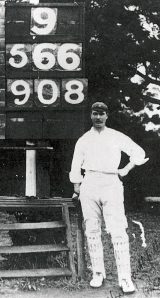
|

Charles Eady poses next to the scoreboard. The team toal is wrong - Break O'Day made 911, but the scorers can be forgiven
© Wisden
|
|
The record established by 13-year-old Arthur Collins in 1899 when, over five afternoons,
he scored 628 runs in a house match at Clifton College in Bristol is one that seems unlikely to be beaten, especially in an era when almost no matches last more than a day.
But before World War Two, quite often games were played to a finish, and if that meant they lasted a number of days, so be it. Whereas school matches such as Collins's could be played any day, in club cricket they had to be slotted in on Saturdays (Sunday cricket was almost unknown until the second quarter of the 20th century).
It was under these circumstances that in 1902, 31-year-old Charles Eady, who had already played two Tests for Australia, scored 566, the second-highest individual score of all time, and the highest in an adult match, over three Saturday afternoons that spanned a month.
Eady was an established figure in Tasmanian cricket, making his debut in 1889-90 and in 1894-95 becoming the first Australian to score hundreds in both innings of a first-class match when he made 116 and 112 not out against Victoria. Given that Tasmania were regarded as Australian cricket's poor relations, it was a mark of how highly Eady was regarded that he was picked to tour England with Australia in 1896. Although he played at Lord's he had a miserable tour, but in late February 1902 he was picked for his second and final Test at the MCG.
He returned from Melbourne in the first week of March just in time to play for his club side, Break O'Day (whose name stemmed from the players getting up at 5.30am to practice) in the final of Southern Tasmanian Cricket Association's pennant competition against rivals Wellington at Hobart.
Wellington won the toss and batted, and took the entire first day (M arch 8) to score 218 for 6. Eady opened the bowling for Break O'Day and by the close had five wickets. Standing in his way was Ken Burn, another two-Test wonder and the premier Tasmanian batsman of the era. He topped the national averages 11 times, and in 1895-96 had scored 123 not out and 213 not out against Break O'Day. He remained unbeaten on 117.
The following Saturday (March 15) the game resumed, and although Burn continued to hit out, he was finally dismissed by Eady for 161 and Wellington were bowled out for 277. Eady had 7 for 87 off 46 five-ball overs.
Although in Test cricket he was considered a bowler who could bat, in club and state cricket Eady was regarded as an allrounder, and as such he opened the Break O'Day innings. By the close, they were 218 for 2, with Eady unbeaten on 130.
Everyone assembled once again a week later, and Wellington took two early wickets, and picked up another pair an hour later to leave Break O'Day on 312 for 6. Under the competition rules, that meant the result was decided as this was a one-innings match. Under the conventions of the day, you played until both innings were completed.
Perhaps Wellington relaxed once the outcome was decided - local reports, however, suggest otherwise - but from there on in, it was a slaughter as Eady and William Abbott added 340 in under four hours. At one stage, Eady, who was methodical more than spectacular, made 144 in 80 minutes. Abbott completed his hundred shortly before the close, while Eady finished on 419. Break O'Day closed on 652 for 6.
There was a fortnight's wait before the game could resume as Easter fell in between and that was when the main match of the local summer, North v South, was held. Eady continued his run of form with 11 for 220 and 72 and 58 but that was not enough to prevent North winning by 17 runs.
But everyone, with the exception of one of the umpires who had to be replaced, returned. The Hobart Mercury praised Wellington's "sportsmanlike spirit throughout the match," adding: "They willingly complied with a request to attend on the final day, although the game and pennant honours were lost."
Burn, however, despite being Wellington's captain appeared to have missed the second and third days and the paper noted that the "loss of his services were more than felt". By missing the third day, he was not there when Eady overtook his Tasmanian record score of 365 made three years earlier.
On the fourth day Eady and Abbott extended their seventh-wicket stand to 429 before Abbott fell, but that brought little respite as Eady found another ally in N Douglas. The pair put on 154 and Eady passed 500 and then 550 before Douglas departed. With only Nos. 10 and 11 remaining, Eady hit out and was finally stumped for 566.
In all he had batted seven hours and 57 minutes, including 13 fives (the reward for hitting the ball over the perimeter fence) 67 fours and 33 threes. The Hobart Mercury noted: "His style of batting was varied, clean and good, while he severely punished the loose bowling, a fair quantity of which was sent down."
Eady continued to dominate Tasmanian cricket until his retirement in 1908, after which he enjoyed a distinguished career in law and politics. The bat he used in his historic innings was sent to Lord's where it remained in the MCC Museum until it was returned to Tasmania in 2003.
Is there an incident from the past you would like to know more about? E-mail us with your comments and suggestions.
Bibliography
The Cricketer Various
The Hobart Mercury April 1902

